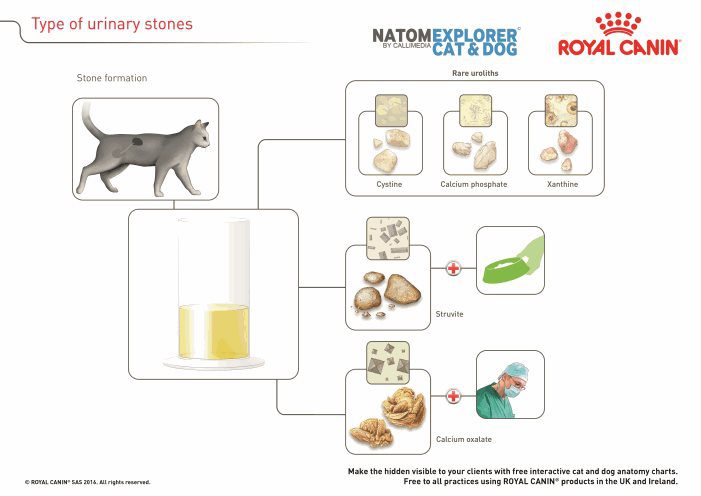
Urolithiasis ee bisadaha iyo eeyaha
Urological problems are one of the main reasons for visiting a veterinary clinic. Cystitis, kidney failure, urolithiasis cover all ages and breeds of cats, dogs and even rodents. Today we will understand in more detail what is urolithiasis.
Urolithiasis (UCD) is a disease characterized by the formation of stones (calculi) in the organs of the urinary system – in the kidneys and bladder.
Contents
Astaamaha ugu caansan
Urolithiasis can be asymptomatic for a long time. The animal does not show anxiety, it has normal urination. However, at one point, symptoms such as:
- difficult urination. Cats sit on the tray for a long time, and as a result, there is no urine at all or a couple of drops, they may refuse to go to the toilet in the tray and look for other places for the toilet. Dogs also sit down or raise their paw for a long time, often to no avail.
- unnatural tense posture when urinating;
- increased anxiety, vocalization, aggression, perineal licking;
- dhiiga kaadida;
- sometimes after urination, you can find sand or even small pebbles;
- frequent urge to go to the toilet, small portions or no urine at all;
- soreness of the abdomen in the area of the bladder or kidneys;
- decrease or lack of appetite.
These symptoms may be signs of other diseases, so it is imperative to carry out diagnostic procedures.
Danger ICD
What is dangerous urolithiasis? Kidney stones can stay for quite a long time and not make themselves felt at all. Sometimes they are an incidental finding when the animal is x-rayed due to another disease or during surgery. The main danger occurs when the calculus enters the ureters – narrow hollow organs through which urine from the kidneys enters the bladder. A stone can create a partial or complete obstruction of the ureter. In the case of complete obstruction in an animal, symptoms develop very quickly. Urine cannot pass, but continues to form, hydronephrosis occurs and the kidney may die. Acute kidney damage develops, characterized by an increase in creatinine, urea, potassium in the blood, which is deadly for cats and dogs. With a timely diagnosis, an operation is performed to remove the stone and place a stent in the ureter. When stones form in the bladder, it is no less scary. In cats and males, a long and thin urethra and small pebbles or sand with mucus, epithelium, blood cells simply get stuck in it. Accordingly, again, obstruction and overflow of the bladder occurs, but the kidneys then “do not know” about this, continuing to produce fluid and acute kidney damage develops again. In cats and bitches, the urethra is usually not clogged. Small stones and sand are passed during urination, but there may be large stones in the bladder cavity. Stones injure the bladder and urethra, causing damage, bleeding, severe inflammation, and can even grow into the mucous membrane. Naturally, all these processes are accompanied by severe pain.
Causes of ICD
There are a lot of factors for the occurrence of urolithiasis:
- Cunto khaldan.
- Violation of mineral and water exchanges in the body.
- Infectious diseases of the urinary system. One of the main causes of urolithiasis in dogs.
- Low fluid intake. As a result, crystals form in highly concentrated urine.
- Saadaalinta hidde.
- Chronic diseases of the excretory system.
- Cadaadiska.
- Low activity.
- Cayil xad dhaaf ah
- Congenital malformations of the urinary system.
Types of crystals
According to their composition and origin, crystals are of different types. It is worth noting that large stones can consist of different types of crystals, blood cells, bladder epithelium, mucus and other substances.
- Struvites are a soluble type of crystals, they are the most common. They are formed mainly in alkaline urine, have a rounded smooth shape and white color.
- Oxalates are the insoluble type. Radiopaque calculi, have sharp edges and corners, and brown color. Formed mainly in acidic urine. Such stones can only be prevented.
- Urates are formed in acidic urine. The detection of this type of stone is highly significant and further investigations are warranted as this problem is often associated with a portosystemic shunt in dogs. They look like grains of sand and pebbles of yellow or brown color.
- Cystins are stones that occur due to cystinuria (impaired absorption of amino acids). The formations are irregular in shape, yellow or white. The disease manifests itself more often in the elderly (over 5 years) age.
1 — struvite 2 — oxalate 3 — urate 4 — cystine
Bioscience
It is important to conduct diagnostic studies in a timely manner.
- General urine analysis. Only a fresh sample should be submitted for testing. Urine that has stood even for a couple of hours is no longer suitable for analysis, since false crystals precipitate in it, respectively, the animal may be erroneously diagnosed.
- General clinical, biochemical blood test to detect renal failure. Also, for the early detection of kidney disease, urine is taken for the ratio of protein / creatinine and blood for SDMA.
- X-ray. Helps to view contrast uroliths.
- ultrasound. Necessary for visualization of structural changes in the kidneys, ureters, bladder. Normally, the ureters are not visible on ultrasound. Studies must be carried out with a full bladder.
- Bacterial culture of urine with subtitration for antibiotics. It is necessary to identify the infection and prescribe the correct treatment. In cats and dogs, urine is taken by cystocentesis to avoid contamination – through a puncture of the abdominal wall with a syringe needle under the control of an ultrasound sensor. Do not worry, animals easily tolerate this procedure.
- Spectral analysis of uroliths. It is carried out after extraction from the animal, it is necessary for accurate diagnosis of the composition of stones, for the choice of further treatment tactics and prevention of the formation of new stones.
Daaweynta
Treatment is aimed at eliminating the cause of urolithiasis and its symptoms. Apply hemostatic drugs, antispasmodics, antimicrobials, if necessary, infusor therapy and forced diuresis. Bladder catheterization with blockage of the urethra, in some cases, washing and instillation of medicinal preparations intravesically. For cats with urinary retention, it is important to provide symptomatic assistance with the emptying of the urinary organs. To do this, catheterization is carefully performed, the bladder cavity is washed, the procedures are performed regularly – until the cat begins to go to the toilet on its own. During surgical treatment, stones are removed from the ureter, bladder or urethra. Sometimes it is necessary to remove the damaged kidney. Also, with recurrent blockage of the urethra or with severe obstruction, a urethrostomy is performed. Of course, after surgical treatment, the animal will need special care: wearing a protective collar or blankets, stitching, taking medications, often requiring a round-the-clock hospital stay under the supervision of veterinarians. Common to therapeutic and surgical treatment is the appointment of specialized diets – dry and wet foods designed for both cats and dogs, and other drugs prescribed by a veterinarian. Self-treatment of the animal in any case should not be.
Ka Hortagga
For prevention, provide the animal with the right exercise, organize proper nutrition. Make sure your pet is getting enough moisture. Try to put several containers of water in the apartment, cats often do not like to drink from a bowl next to their food. Also, in addition to croquettes, add pouches or pâtés to your diet. It is recommended to use wet and dry food from the same manufacturer. And, of course, regularly check with the veterinarian, especially if you know that the pet is prone to urolithiasis.





